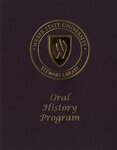| Title |
Buss, Walter OH4_029 |
| Creator |
Weber State University, Stewart Library: Oral History Program |
| Contributors |
Buss, Walter, Interviewee; Sadler, Richard; Interviewer |
| Collection Name |
Weber State College Oral Histories |
| Description |
The Weber State College Oral History Program was created in the early 1970s to "record and document, through personal reminiscences, the history, growth and development of Weber State College." Through interviews with administrators, faculty and students, the program's goal was to expand the documentary holdings on Weber State College and its predecessor entities. From 1970 to 1976, the program conducted some fifteen interviews, under the direction of, and generally conducted by Harold C. Bateman, an emeritus professor of history. In 1979, under the direction of archivist John Sillito, the program was reestablished and six interviews were conducted between 1979 and 1983. Additional interviews were conducted by members of the Weber State community. |
| Biographical/Historical Note |
This is an oral history interview with Dr. Walter Richard Buss. It was conducted on July 29, 1981 at the Social Science Building of Weber State College and concerns his early life and his Weber State geology trip experiences. The interviewer is Dr. Richard Sadler. |
| Subject |
Weber State College; Geology; Geography; College teaching; Fieldwork |
| Digital Publisher |
Stewart Library, Weber State University, Ogden, Utah, USA |
| Date |
1981 |
| Date Digital |
2017 |
| Temporal Coverage |
1905; 1906; 1907; 1908; 1909; 1910; 1911; 1912; 1913; 1914; 1915; 1916; 1917; 1918; 1919; 1920; 1921; 1922; 1923; 1924; 1925; 1926; 1927; 1928; 1929; 1930; 1931; 1932; 1933; 1934; 1935; 1936; 1937; 1938; 1939; 1940; 1941; 1942; 1943; 1944; 1945; 1946; 1947; 1948; 1949; 1950; 1951; 1952; 1953; 1954; 1955; 1956; 1957; 1958; 1959; 1960; 1961; 1962; 1963; 1964; 1965; 1966; 1967; 1968; 1969; 1970; 1971; 1972 |
| Medium |
Oral History |
| Spatial Coverage |
Ogden (Utah) |
| Type |
Text; Sound; Image/StillImage |
| Conversion Specifications |
Sound was recorded with an audio reel-to-reel casette recorder. Reel-to-reel recording was converted to digital file. Transcribed using Express Scribe. Digitall reformatted using Adobe Acrobat XI Pro. |
| Language |
eng |
| Rights |
Materials may be used for non-profit and educational purposes, please credit University Archives, Stewart Library; Weber State University. |
| Source |
Buss, Walter OH4_029; Weber State University, Stewart Library, University Archives |
| Format |
application/pdf; audio/mpeg |
| ARK |
ark:/87278/s66pxa3b |
| Setname |
wsu_oh |
| ID |
111903 |
| Reference URL |
https://digital.weber.edu/ark:/87278/s66pxa3b |
| Title |
Buss, Walter OH4_029 |
| Creator |
Weber State University, Stewart Library: Oral History Program |
| Contributors |
Buss, Walter, Interviewee; Sadler, Richard; Interviewer |
| Description |
The Weber State College Oral History Program was created in the early 1970s to “record and document, through personal reminiscences, the history, growth and development of Weber State College.” Through interviews with administrators, faculty and students, the program’s goal was to expand the documentary holdings on Weber State College and its predecessor entities. From 1970 to 1976, the program conducted some fifteen interviews, under the direction of, and generally conducted by Harold C. Bateman, an emeritus professor of history. In 1979, under the direction of archivist John Sillito, the program was reestablished and six interviews were conducted between 1979 and 1983. Additional interviews were conducted by members of the Weber State community. |
| Biographical/Historical Note |
This is an oral history interview with Dr. Walter Richard Buss. It was conducted on July 29, 1981 at the Social Science Building of Weber State College and concerns his early life and his Weber State geology trip experiences. The interviwer is Dr. Richard Sadler. |
| Subject |
Weber State College; Geology; Georgraphy; College teaching; Fieldwork |
| Digital Publisher |
Stewart Library, Weber State University, Ogden, Utah, USA |
| Date |
1981 |
| Date Digital |
2017 |
| Temporal Coverage |
1905-1972 |
| Medium |
Oral History |
| Spatial Coverage |
Ogden (Utah) |
| Type |
Text; Sound; Image |
| Conversion Specifications |
Sound was recorded with an audio reel-to-reel casette recorder. Reel-to-reel recording was converted to digital file. Transcribed using Express Scribe. Digitall reformatted using Adobe Acrobat XI Pro. |
| Language |
eng |
| Rights |
Materials may be used for non-profit and educational purposes, please credit University Archives, Stewart Library; Weber State University. |
| Source |
Buss, Walter OH4_029; Weber State University, Stewart Library, University Archives |
| Format |
application/pdf |
| Setname |
wsu_oh |
| ID |
111946 |
| Reference URL |
https://digital.weber.edu/ark:/87278/s66pxa3b/111946 |





